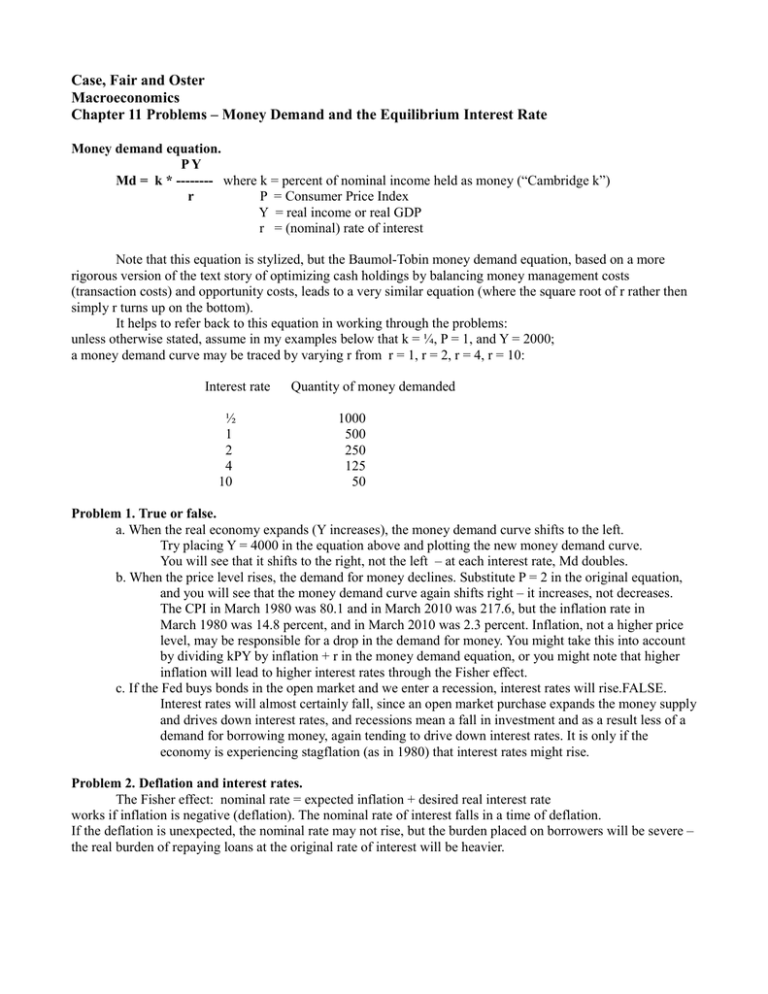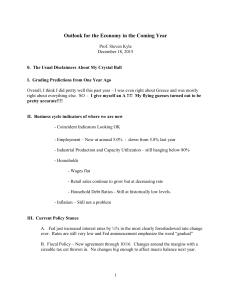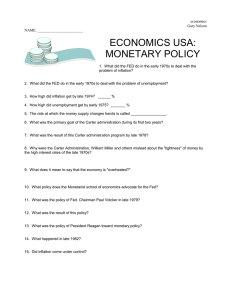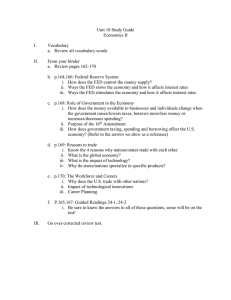Money Demand and the Interest Rate
advertisement

Case, Fair and Oster Macroeconomics Chapter 11 Problems – Money Demand and the Equilibrium Interest Rate Money demand equation. PY Md = k * -------- where k = percent of nominal income held as money (“Cambridge k”) r P = Consumer Price Index Y = real income or real GDP r = (nominal) rate of interest Note that this equation is stylized, but the Baumol-Tobin money demand equation, based on a more rigorous version of the text story of optimizing cash holdings by balancing money management costs (transaction costs) and opportunity costs, leads to a very similar equation (where the square root of r rather then simply r turns up on the bottom). It helps to refer back to this equation in working through the problems: unless otherwise stated, assume in my examples below that k = ¼, P = 1, and Y = 2000; a money demand curve may be traced by varying r from r = 1, r = 2, r = 4, r = 10: Interest rate ½ 1 2 4 10 Quantity of money demanded 1000 500 250 125 50 Problem 1. True or false. a. When the real economy expands (Y increases), the money demand curve shifts to the left. Try placing Y = 4000 in the equation above and plotting the new money demand curve. You will see that it shifts to the right, not the left – at each interest rate, Md doubles. b. When the price level rises, the demand for money declines. Substitute P = 2 in the original equation, and you will see that the money demand curve again shifts right – it increases, not decreases. The CPI in March 1980 was 80.1 and in March 2010 was 217.6, but the inflation rate in March 1980 was 14.8 percent, and in March 2010 was 2.3 percent. Inflation, not a higher price level, may be responsible for a drop in the demand for money. You might take this into account by dividing kPY by inflation + r in the money demand equation, or you might note that higher inflation will lead to higher interest rates through the Fisher effect. c. If the Fed buys bonds in the open market and we enter a recession, interest rates will rise.FALSE. Interest rates will almost certainly fall, since an open market purchase expands the money supply and drives down interest rates, and recessions mean a fall in investment and as a result less of a demand for borrowing money, again tending to drive down interest rates. It is only if the economy is experiencing stagflation (as in 1980) that interest rates might rise. Problem 2. Deflation and interest rates. The Fisher effect: nominal rate = expected inflation + desired real interest rate works if inflation is negative (deflation). The nominal rate of interest falls in a time of deflation. If the deflation is unexpected, the nominal rate may not rise, but the burden placed on borrowers will be severe – the real burden of repaying loans at the original rate of interest will be heavier. Problem 3. A world without ATMs. Go back to the dark ages by going to the FRED (Federal Reserve Economic Data) database (simply Google “FRED2”,which is the latest version of the database to get there quickly), then go to “Monetary Aggregates” and finally to “Components of M1.” Get graphs of currency holdings and demand deposits. What really counts is the ratio of the currency holdings and demand deposits to nominal GDP: Select 3 dates: Currency/GDP Demand deposits / GDP Jan 1980 105.1 / 2724.1 = 3.8 % 264.3 / 2724.1 = 9.7 % Jan 2007 748.4 / 13795.6 = 5.4 % 302.1 / 13795.6 = 2.2 % Jan 2010 860.2 / 14500 = 5.9 % 430.2 / 14500 = 3.0 % Note that currency behaves strangely – shooting up steadily after 1990 (breakup of the Soviet Union?), with an interesting spike in December 1999 (why?) – and again in late 2008 (again, why?). Demand deposits behave as if they were being steadily crowded out by financial innovation – easier access to the commercial paper market for firms, and ATMs for households. Problem 4. The Liquidity Trap. Note that our graphs of the money demand function showed that the curve was not a straight line, but a hyperbola – that is, after some point the graph becomes flatter and flatter. The result is that a shift in the money supply curve will not drive down the interest rate very much. Expanding the money supply from 50 to 250 (by 200) drives down the interest rate from 10 percent to 2 percent, or by 8 percentage points; expanding the money supply from 1000 to 2000 (by 1000 or 5 times as much as in the previous example) reduces the interest rate by only one-quarter of a point – from 0.50 to 0.25. As the Fed expands the money supply, it becomes less and less effective at driving down the interest rate, and therefore less and less effective at stimulating the economy. Problem 5. Does Fed policy always work? Not if price and real income growth drive interest rates up faster than money supply expansion can bring interest rates down: Note that the money demand equation can be rewritten with the interest rate on the left hand side, and with equilibrium between money supply and money demand allowing us to replace Md simply with M: P Y r = k * -----------M Which can be translated into percentage change form as (note that % Δ k = 0 unless preferences for holding money change) %Δr= %Δ P + 7 = 3 + % ΔY - % ΔM 4 - 0 The data of part a of the question implies that without any rise in the money supply, the inflation of 3 percent and the real GDP growth of 4 percent should have led to a 7 percent increase in the interest rate. (Note: this should not mean that the interest rate goes from 6 percent to 13 percent, but from 6 percent to 6 * (1.07) = 6.42 percent). Note also that an expansion in the money supply would have to be greater that 7 percent to stop the interest rate from rising. The graph below begins from our original money demand equation (Md = 500 / r), and adds another money demand which would result from higher prices or income: Md = 1200 / r). With these equations, an increase in the money supply from 500 to 800 would be accompanied by an increase in the interest rate from 1 percent to 1.5 percent. Just as in the law of demand, if other things don't stay equal, we can't expect to be moving along the same money demand curve. Problem 6. Money supply and money demand. Translate the described situations into shifts on a graph: a. Fed buys bonds in an open market during a recession. Money supply increases, the vertical Ms curve shifts to the right, and the interest rate drops. b. During a period of rapid inflation, the Fed increases the reserve requirement, contracting the money supply. Ms curve shifts to the right, raising interest rates in the new equilibrium. The Fed is hoping to “cool down” the economy and so to limit inflation. c. The Fed tries to hold interest rates constant during a period of high inflation. The Fed might be able to fight the Fisher effect (which would push nominal interest rates up, so that real rates would stay constant) for a while – by increasing the money supply. But this is all too likely to lead to higher anticipated inflation and more pressure upwards on interest rates. d. The Fed lowers the discount rate during a period of no growth in GDP and zero inflation. The money supply will increase as the banks borrow more from the Fed, and the increase in the money supply will lower the interest rate and so (the Fed hopes) stimulate investment spending by firms (who will be tempted to borrow at the lower rate for new plant and equipment) and by households (home building). e. During a period of rapid growth of GDP, the Fed increases the reserve requirement. See part (b). The Fed presumably fears that the rapid growth will lead to inflation. Problem 7. Interest rates fall in a recession. During a recession, interest rates may fall even if the Fed takes no action to expand the money supply. Go back to problem 5 and the money demand equation with interest rates on the left hand side: P Y r = k * -----------M As Y (real GDP) will certainly drop during a recession, the interest rate will drop even if M stays constant. It is also typical that prices fall during a recession, which will reinforce the effect. See the problem 5 graph, and consider the money supply fixed at 500 while income falls from 2000 to 1600. The money demand curve shift can be seen as one from the blue curve to the red curve. With our assumed value for k (¼), and assuming the price level stays constant at 1, we would have have the interest rate falling from r = 0.25 * 1 * 2000 / 500 = 1 percent. to r = 0.25 * 1 * 1600 / 500 = 4/5 or 0.8 percent. Problem 8. Balancing the Budget The Clinton budget balancing plan of 1997 cut taxes immediately, with expenditure cuts scheduled for later (in 1999-2000) to balance the budget (which, to almost everyone's surprise, was in fact done). Fed policy to hold interest rates steady would have involved expanding the money supply to offset the impact economic growth would have in raising the rate of interest, and after 1999, contracting the money supply to offset the fall in the interest rate as the rate of economic growth slowed down. Note that the Fed's targeting of the interest rate would have magnified the impact of fiscal policy on GDP. Problem 9. Demand for Money in Linear Form. Note that the given form for the money demand equation, Md = 10,000 – 10,000 r + Y has several problems: a.It is less realistic than the form given in the introduction to this problem. b.If r = 1, (which means 100 percent in terms of the text notation), Md = Y, which is unrealistic. I will stick with the “divide by r” form of the money demand equation on any exam. But for now, note that we can rearrange the text money demand equation as: r = 1.0 + Y / 10,000 - Md / 10,000 and with Y = 5000 (as in part a), r = 1.5 – M / 10,000 With Y = 7500, as in part c, r = 1.75 – M / 10000 a.If Y = 5000, Md = 15,000 – 10,000 r. If r = 0, Md = 10,000; if r = 1.5, Md = 0. b.If the money supply is set at 10,000, and Y remains at 5000, we can solve for r: 10,000 = 15,000 – 10,000 r will yield r = 5,000 / 10,000 = 0.5 c.If Y increases to 7500, we would have Md = 17,500 – 10,000 r and with Ms at 10,000, we would get 17,500 – 10,000 = 10,000 r or r = 0.75. An increase in Y would cause a shift in the money demand curve. d.If the Fed wanted to keep the interest rate steady, it would have to increase the money supply: the money demand equation reveals the target money supply: M = 10,000 – 10,000 (0.5) + 7500 M = 17,500 - 5,000 = 12,500







